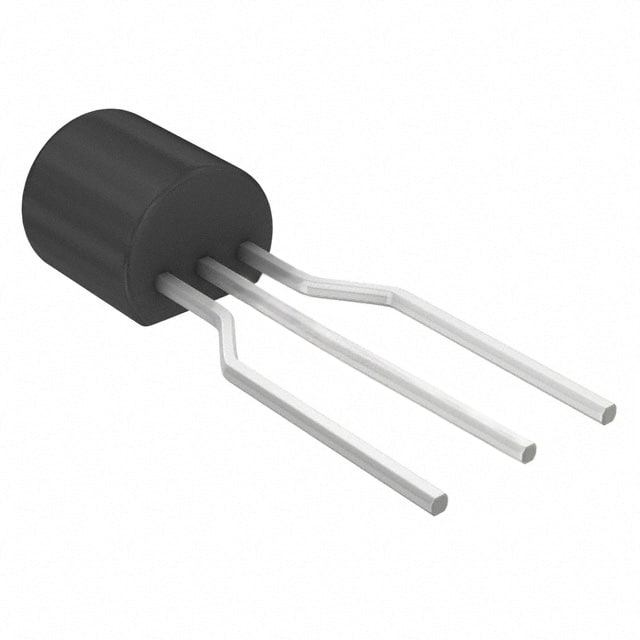BC548ATF Transistor
Product Category: Electronic Component
Basic Information Overview: - Category: Bipolar Junction Transistor (BJT) - Use: Amplification and switching in electronic circuits - Characteristics: Low power, low noise, high voltage, and current gain - Package: TO-92 package - Essence: Small-signal NPN transistor - Packaging/Quantity: Typically available in reels of 2000 units
Specifications: - Maximum Collector-Emitter Voltage: 30V - Maximum Collector Current: 100mA - DC Current Gain (hFE): 110 - 800 - Transition Frequency (fT): 300MHz
Detailed Pin Configuration: The BC548ATF transistor has three pins: 1. Emitter (E): Connected to the N-type material and is the source of electrons. 2. Base (B): Controls the flow of electrons from the emitter to the collector. 3. Collector (C): Attracts and collects the electrons from the emitter.
Functional Features: - High current gain - Low noise - Suitable for audio amplification and signal processing circuits
Advantages: - Versatile applications in electronic circuits - Low cost and widely available - Reliable performance in low-power applications
Disadvantages: - Limited maximum voltage and current ratings - Susceptible to temperature variations
Working Principles: The BC548ATF operates based on the principles of bipolar junction transistors, where the flow of current between the emitter and collector is controlled by the base current. It amplifies or switches electronic signals based on the input at the base terminal.
Detailed Application Field Plans: - Audio amplification circuits - Signal processing and filtering circuits - Oscillator and waveform generator circuits
Detailed and Complete Alternative Models: - 2N3904 - BC547 - 2N2222
This completes the entry for the BC548ATF transistor, providing comprehensive information about its category, specifications, pin configuration, functional features, advantages, disadvantages, working principles, application field plans, and alternative models.
قم بإدراج 10 أسئلة وإجابات شائعة تتعلق بتطبيق BC548ATF في الحلول التقنية
What is the BC548ATF transistor used for?
- The BC548ATF transistor is commonly used for amplification and switching applications in electronic circuits.
What are the key specifications of the BC548ATF transistor?
- The BC548ATF transistor is a general-purpose NPN bipolar junction transistor (BJT) with a maximum collector current of 100mA, a maximum collector-emitter voltage of 30V, and a maximum power dissipation of 500mW.
How do I identify the pinout of the BC548ATF transistor?
- The pinout of the BC548ATF transistor is typically identified as the emitter (E), base (B), and collector (C) when viewing the flat side of the transistor with the pins facing downward.
Can the BC548ATF be used for audio amplifier circuits?
- Yes, the BC548ATF can be used in low-power audio amplifier circuits due to its ability to amplify small signals.
What are some common circuit configurations using the BC548ATF transistor?
- Common circuit configurations include common-emitter amplifiers, switch circuits, and oscillator circuits.
What are the typical operating conditions for the BC548ATF transistor?
- The BC548ATF transistor is typically operated within a temperature range of -55°C to 150°C and is suitable for low to moderate frequency applications.
Can the BC548ATF be used for driving small motors or relays?
- Yes, the BC548ATF can be used to drive small motors or relays by acting as a switch to control the flow of current.
Are there any common alternatives to the BC548ATF transistor?
- Common alternatives include the 2N3904, 2N2222, and PN2222 transistors, which have similar characteristics and can be used in its place in many circuits.
What are the typical gain characteristics of the BC548ATF transistor?
- The BC548ATF transistor has a typical DC current gain (hFE) ranging from 110 to 800, depending on the operating conditions and biasing.
Where can I find detailed datasheets and application notes for the BC548ATF transistor?
- Detailed datasheets and application notes for the BC548ATF transistor can be found on semiconductor manufacturer websites or electronics component distributor websites.


